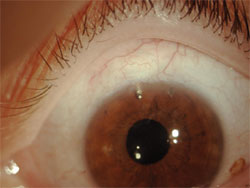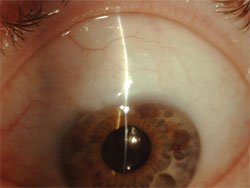Glaucoma drainage device under large scleral flap allows long-term IOP control with minimal bleb creation
The procedure combines the benefits of trabeculectomy and nonpenetrating glaucoma surgery, according to a clinician.
PARIS — Implantation of a glaucoma drainage device under a large scleral flap provides good IOP control with minimal bleb formation, according to a specialist.
“The implantation procedure is in fact a standardized trabeculectomy without iridectomy and no need of scleral tissue removal. The procedure combines the benefits of trabeculectomy and nonpenetrating glaucoma surgery while it diminishes their drawbacks. The sight-threatening complications of trabeculectomy are greatly reduced and, at the same time, you do not need the long learning curve for mastering nonpenetrating glaucoma surgery,” Elie Dahan, MD, said at the European Society of Cataract and Refractive Surgeons meeting here.
The Ex-PRESS (Alcon) device was originally designed in the late 1990s to be implanted directly under the conjunctiva. In 2000, Dr. Dahan was the first glaucoma surgeon to propose Ex-PRESS implantation under a scleral flap rather than under the conjunctiva. He said that the scleral flap would prevent device extrusion, which often occurs with implantation under the conjunctiva.
Two methods
There are two main approaches for implanting the device under a scleral flap. In the U.S., most surgeons prefer creating a small, 3 × 3 mm triangular scleral flap and applying mitomycin C under the conjunctiva.
 Figure 1. Example of bleb absence with the Ex-PRESS under scleral flap 6 years after implantation. The patient’s IOP is 13 mm Hg without any anti-glaucoma medications. |
 Figure 2. Example of a low diffuse bleb with the Ex-PRESS under scleral flap. |
|
|
|
|
Figure 3. Example of an intrascleral bleb (a)
evidenced by ultrasound biomicroscopy (b) (courtesy of André Mermoud).
Note the adhesion of the conjunctiva over the sclera that is elevated by the
formulation of an intrascleral bleb. |
|
 Figure 4. Example of a high conjunctival bleb with the Ex-PRESS under scleral flap. Images: Dahan E |
“This method may create high avascular blebs,” Dr. Dahan said.
In Europe and South Africa, where more glaucoma surgeons are familiar with nonpenetrating glaucoma surgery, a larger, 5 × 5 mm square or trapezoidal scleral flap is used.
“Coming from the school of [nonpenetrating glaucoma surgery], it was natural for me to use the larger flap,” Dr. Dahan said. “I apply MMC on the scleral bed only and I spare the conjunctiva in order to obtain low and diffused blebs. In some instances it is possible to recognize intrascleral bleb formation confirmed by [ultrasound biomicroscopy] imaging. This is really what we want to achieve with this surgery.”
A combination of factors leads to reduced conjunctival bleb formation with this surgical technique, he said. A 5 × 5 mm square scleral flap exposes a scleral surface of 25 mm² that is more than five times larger than the 4.5 mm² area obtained with the 3 × 3 mm triangular scleral flap.
“Consequently, the 5 × 5 mm scleral bed contains five times more aqueous veins than the 3 × 3 mm scleral bed, so its aqueous-absorbing capacity is also greater. More of the aqueous humor is absorbed by the aqueous veins in the larger scleral bed before it reaches the subconjunctival space,” he said.
In addition, applying MMC to the scleral bed only and sparing the conjunctiva weakens intrascleral healing and allows intrascleral bleb formation.
Finally, conjunctival sparing reduces conjunctival weakening, which tends to create high avascular blebs, also allowing normal healing of the conjunctiva over the scleral flap, he said.
Benefit of method
This method provides long-term reduction of IOP and obviates anti-glaucoma medication use, Dr. Dahan said. Between 2000 and 2010, he has implanted hundreds of Ex-PRESS devices in South Africa, Europe and Israel. Ninety-six eyes of 72 patients with the Ex-PRESS device were followed for up to 6 years in South Africa. Good long-term IOP control was achieved with practically no anti-glaucoma medication use.
“More than 80% of the patients showed minimal or no visible conjunctival blebs,” he said. “No correlation was found between success rate (IOP = 18 mm Hg) and bleb appearance. In other words, shallow, diffuse blebs and high blebs showed the same success or failure rates. Those patients who developed high blebs needed more surgical revisions because of discomfort and/or blebitis risk.” – by Michela Cimberle

- Elie Dahan, MD, can be reached at the Ein Tal Eye Center, 17 Brandeis St., Tel Aviv, 62001 Israel; e-mail: elie.dahan@gmail.com.
- Disclosure: Dr. Dahan was a scientific consultant to Optonol, manufacturer of the Ex-PRESS device, until it was acquired by Alcon.

![]()
The use of the Ex-PRESS implant (Alcon) under the scleral flap offers an excellent bleb formation and IOP control. It is a very easy surgical procedure with a high safety profile. The big flap promotes the formation of a more diffused bleb and therefore decreases the number of late postoperative complications, including hypotony and infection (blebitis).
A simple procedure to treat glaucoma will allow more specialists to offer surgery as a first-line treatment to a higher number of patients. It will also encourage more ophthalmologists to operate on their patients earlier in order to reduce the need for medications and enhance safety in the long-term follow-up.
The number of cases in Dr. Dahan’s study is relatively small and a larger study will probably give us more information on the definitive advantages of such a technique. In our experience, we have similar results to those described by the author. We are also doing deep sclerectomy. It promotes an intrascleral bleb, which definitely decreases the volume of the subconjunctival bleb.
— André Mermoud, MD
Montchoisi
Glaucoma Center, Lausanne, Switzerland
Disclosure: Dr. Mermoud has no
proprietary interest in the products discussed in this article.


